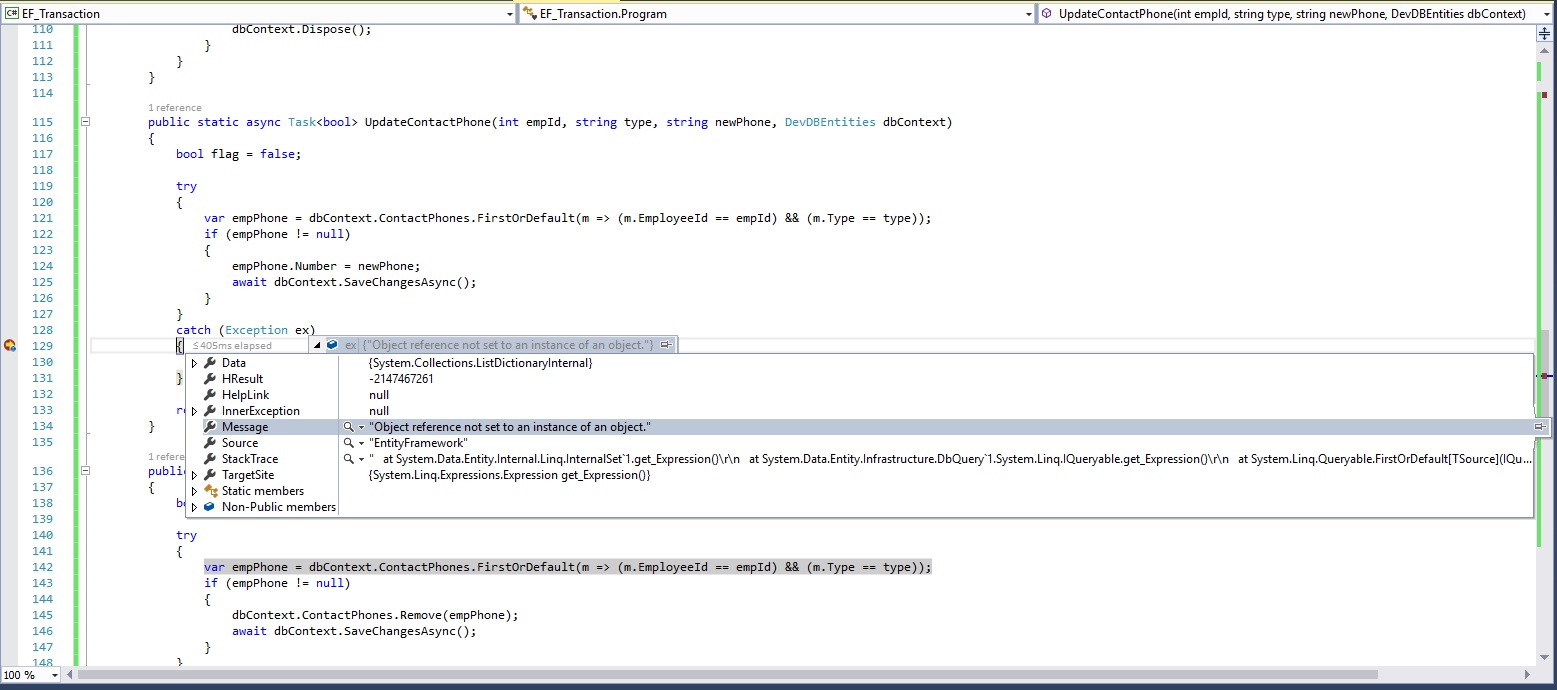I have an Employee object, I'm trying to update a record (i.e., Update / Remove) using a multiple task (Parallel Execution) using single DB Entity Context. But I'm getting the following exception
Message = "Object reference not set to an instance of an object."
Consider the following DTO's
public class Employee
{
public int EmployeeId { get; set; }
public string FirstName { get; set; }
public string LastName { get; set; }
public List<ContactPhone> ContactPhoneNumbers { get; set; }
public List<ContactEmail> ContactEmailAddress { get; set; }
}
public class ContactPhone
{
public int ContactId { get; set; }
public string Type { get; set; }
public string Number { get; set; }
}
public class ContactEmail
{
public int ContactId { get; set; }
public string Type { get; set; }
public string Number { get; set; }
}
Employee Table:
EmployeeId FirstName LastName
_________________________________
1 Bala Manigandan
ContactPhone Table:
ContactId EmployeeId Type Number
__________________________________________
1 1 Fax 9123456789
2 1 Mobile 9123456789
ContactPhone Table:
ContactId EmployeeId Type EmailAddress
______________________________________________
1 1 Private [email protected]
2 1 Public [email protected]
In-Coming API Object is
DTO.Employee emp = new DTO.Employee()
{
EmployeeId = 1,
FirstName = "Bala",
LastName = "Manigandan",
ContactPhoneNumbers = new List<DTO.ContactPhone>
{
new DTO.ContactPhone()
{
Type = "Mobile",
Number = "9000012345"
}
},
ContactEmailAddress = new List<DTO.ContactEmail>()
{
new DTO.ContactEmail()
{
Type = "Private",
EmailAddress = "[email protected]"
},
new DTO.ContactEmail()
{
Type = "Public",
EmailAddress = "[email protected]"
}
}
};
I'm getting an API request to update Mobile number and to remove the Fax number for a specified Employee.
Consider the task methods:
public void ProcessEmployee(DTO.Employee employee)
{
if(employee != null)
{
DevDBEntities dbContext = new DevDBEntities();
DbContextTransaction dbTransaction = dbContext.Database.BeginTransaction();
List<Task> taskList = new List<Task>();
List<bool> transactionStatus = new List<bool>();
try
{
Employee emp = dbContext.Employees.FirstOrDefault(m => m.EmployeeId == employee.EmployeeId);
if (emp != null)
{
Task task1 = Task.Factory.StartNew(() =>
{
bool flag = UpdateContactPhone(emp.EmployeeId, employee.ContactPhoneNumbers.FirstOrDefault().Type, employee.ContactPhoneNumbers.FirstOrDefault().Number, dbContext).Result;
transactionStatus.Add(flag);
});
taskList.Add(task1);
Task task2 = Task.Factory.StartNew(() =>
{
bool flag = RemoveContactPhone(emp.EmployeeId, "Fax", dbContext).Result;
transactionStatus.Add(flag);
});
taskList.Add(task2);
}
if(taskList.Any())
{
Task.WaitAll(taskList.ToArray());
}
}
catch
{
dbTransaction.Rollback();
}
finally
{
if(transactionStatus.Any(m => !m))
{
dbTransaction.Rollback();
}
else
{
dbTransaction.Commit();
}
dbTransaction.Dispose();
dbContext.Dispose();
}
}
}
public async Task<bool> UpdateContactPhone(int empId, string type, string newPhone, DevDBEntities dbContext)
{
bool flag = false;
try
{
var empPhone = dbContext.ContactPhones.FirstOrDefault(m => (m.EmployeeId == empId) && (m.Type == type));
if (empPhone != null)
{
empPhone.Number = newPhone;
await dbContext.SaveChangesAsync();
flag = true;
}
}
catch (Exception ex)
{
throw ex;
}
return flag;
}
public async Task<bool> RemoveContactPhone(int empId, string type, DevDBEntities dbContext)
{
bool flag = false;
try
{
var empPhone = dbContext.ContactPhones.FirstOrDefault(m => (m.EmployeeId == empId) && (m.Type == type));
if (empPhone != null)
{
dbContext.ContactPhones.Remove(empPhone);
await dbContext.SaveChangesAsync();
flag = true;
}
}
catch (Exception ex)
{
throw ex;
}
return flag;
}
I'm getting following exception:
Message = "Object reference not set to an instance of an object."
Here with I'm attaching the screenshot for your reference
My requirement is to do all the database UPSERT processes in parallel execution, kindly assist me how to achieve this without any exception using Task


employee.ContactPhoneNumbers.FirstOrDefault().Type, employee.ContactPhoneNumbers.FirstOrDefault(). As a side note, DbContext is not thread safe, so be careful when you play around with context in threads – PatronymicdbContextandtransactionStatusinside of threads with no limit to access. You must lock aroundtransactionStatusand give each thread their owndbContext. – Jacksmelt